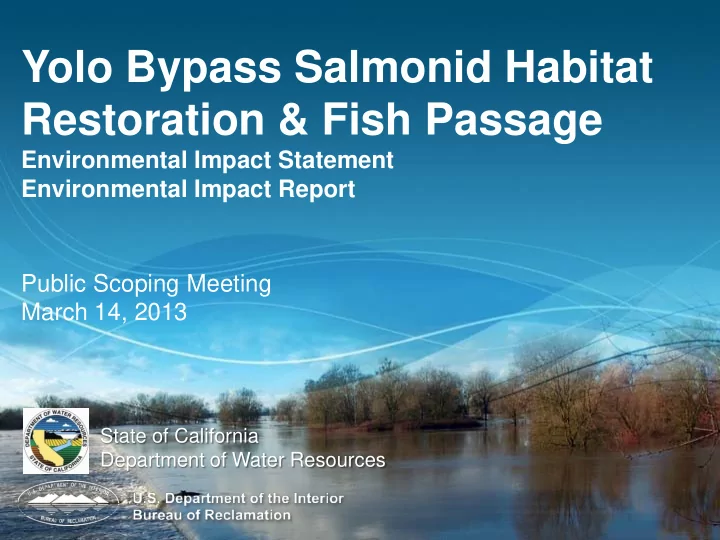

Yolo Bypass Salmonid Habitat Restoration & Fish Passage Environmental Impact Statement Environmental Impact Report Public Scoping Meeting March 14, 2013 State of California Department of Water Resources
Who We Are • Bureau of Reclamation, Bay-Delta Office – National Environmental Policy Act (NEPA) Lead Agency – Traci Michel, Project Manager • California Department of Water Resources – California Environmental Quality Act (CEQA) Lead Agency – Marianne Kirkland, Project Manager • CDM Smith and HDR, Inc., Joint Venture – Consultant Team – Carrie Buckman, Project Manager
Scoping Meeting Outline • 30 Minutes Overview Presentation • 90 Minutes Open House Stations
Overview Presentation Agenda • Overview of the Yolo Bypass Salmonid Habitat Restoration and Fish Passage Project - Planning and Environmental Compliance Phase – Project Background – Project Overview – Key Project Components • Planning and Environmental Compliance Process • Proposed Project Schedule • Next Steps
What is Public Scoping? Public scoping invites agencies, stakeholders, and the interested public to participate in the environmental review process Scoping helps to identify and refine potential: • Options and alternatives • Environmental impacts • Mitigation measures Notice of Intent and Notice of Preparation published on March 4, 2013
Project Background 2009 National Marine Fisheries Service (NMFS) Biological Opinion (BO) • Reasonable and Prudent Alternative (RPA) Actions – RPA Action I.6.1 - Increase seasonal floodplain inundation in the lower Sacramento River Basin – RPA Action I.7 – Improve fish passage throughout the Yolo Bypass • Required an Implementation Plan
Implementation Plan • Describes the activities, process, and timeline required to implement RPA Actions I.6.1 and I.7 – Biological objectives and performance measures – Potential actions for further consideration – Planning and environmental compliance process – Milestones The completed Implementation Plan can be accessed at the Project’s website: http://www.usbr.gov/mp/BayDeltaOffice/Documents/yolo.html
Related Efforts • Bay Delta Conservation Plan (BDCP) • Delta Plan • Central Valley Flood Protection Plan (CVFPP) • Remanded Biological Opinions • Integrated Regional Water Management Planning • Others
Comparison of RPA Actions I.6.1 and I.7 and BDCP Conservation Measure 2 (CM2) RPA Actions I.6.1 and I.7 BDCP CM 2 Avoid jeopardizing Conservation and Endangered Species Act management of BDCP Objective (ESA) listed species covered species Acreage Target 17,000-20,000 acres 7,000 – 17,000 acres I.6.1 - Lower Sacramento River Basin Plan Area Yolo Bypass I.7 - Yolo Bypass
Vicinity Map Legend Yolo Bypass Area Features
Purpose and Need/Project Objectives • Need: – Decline in abundance, spatial distribution, and life history diversity associated with ESA-listed fish species – Lost habitat quality and ability to access that habitat • Purpose: – Create more suitable conditions for fish in the Yolo Bypass and/or lower Sacramento River basin by implementing RPA Actions I.6.1 and I.7
Potential Elements for Alternatives • Physical and operational modifications at Fremont, Sacramento and Lisbon weirs • Removal of barriers to fish passage within the Bypass • Actions to improve connectivity to reduce fish stranding in the Bypass • Modifications at Knights Landing Ridge Cut and/or Wallace Weir to reduce adult fish straying • Changes in inundation periods, durations, and acreages in the Bypass • Other measures suggested through the scoping process
Potential Environmental Effects • Key resource areas that have the potential to be affected by the Project include: – Water resources, including water quality, groundwater & water supply, and flood control – Land use, including agriculture – Biological resources, including fish, wildlife, and plant species – Air quality – Global climate change – Recreation
Planning and Environmental Compliance • Evaluate a range of alternatives that meet the project purpose and could reduce or avoid environmental impacts • Provide information for public review and comment • Identify any significant environmental impacts • Disclose the impacts, mitigation, and public comments
Environmental Compliance Process Public Publication Preparation of Publication of Meetings/ Final Public NMFS BO of Final Scoping EIS/EIR Draft EIS/EIR Comment Decision EIS/EIR Period We are here
Proposed Schedule
Overall Project Implementation 2013-2016 2014-2016 2016-2019 2019+ Operations & Pre- Planning & Construction Management Construction Environmental & Design Compliance Ongoing Public Involvement & Agency Consultation/Permitting
Next Steps • All public comments due by April 4, 2013 • Reclamation and DWR will consider public input to develop and screen project alternatives and analyze and disclose project impacts • Next opportunity for public comment will be during the public review period for the Draft EIS/EIR
How to Comment • Provide oral comments to the court reporter at Station 4 • Fill out a comment form and return it to the comment box at Station 4 • By April 4, mail the comment card to the address on the back; or mail, email or fax a letter to the contact information below Bay-Delta Office Attention: Traci Michel Bureau of Reclamation, Interior Telephone: (916) 414-2420 801 I Street, Suite 140 Fax: (916) 414-2439 Sacramento, CA 95814-2536 Email: tmichel@usbr.gov Please include your name, address, and email address.
Resources • Project Websites: – http://www.water.ca.gov/environmentalservices/yolo_by pass_salmonid.cfm – http://www.usbr.gov/mp/BayDeltaOffice/Documents/yol o.html • Project Managers: – Marianne Kirkland, DWR marianne.kirkland@water.ca.gov – Traci Michel, Reclamation tmichel@usbr.gov
Stations • Station 1 – Project area, purpose and need, potential elements for alternatives • Station 2 – Relationships to other projects and initiatives, environmental review process, public scoping process • Station 3 – Key resource areas • Station 4 – How to submit comments
Recommend
More recommend